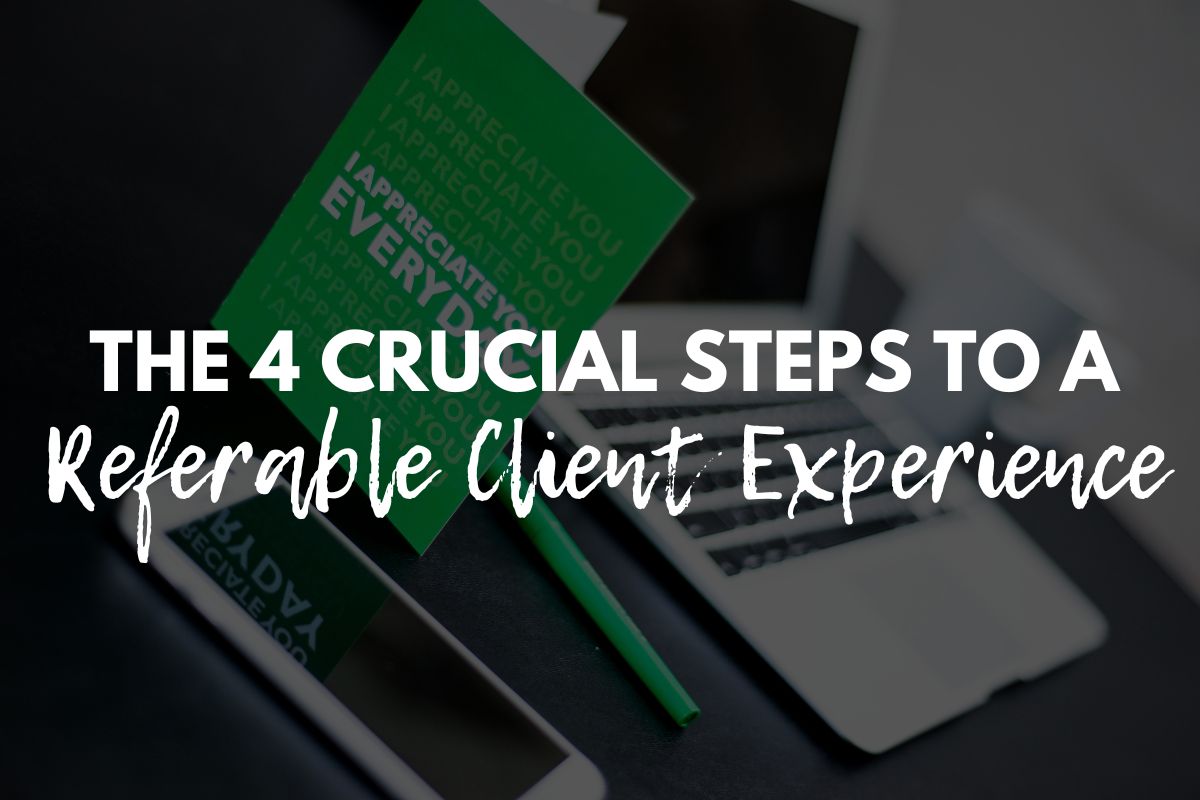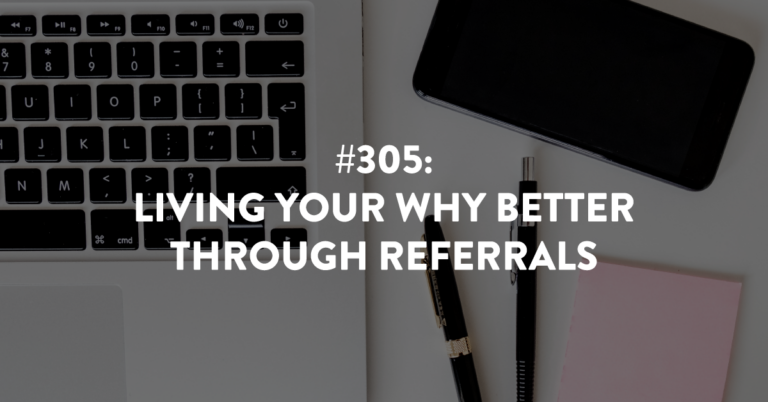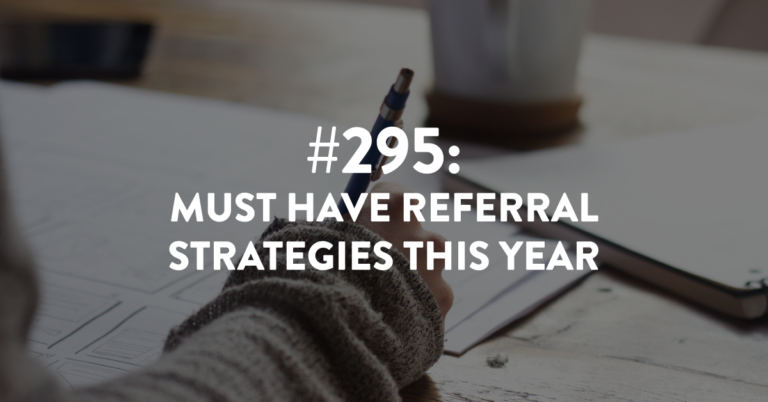Four Crucial Steps to a Referable Client Experience
When I say client experience, what do you hear?
I wouldn’t be surprised if you answered with…
“Isn’t that the same as customer service?”
Or
“What the heck?”
Or
“Sounds like a lot of work.”
Don’t worry, if you haven’t heard of the term “client experience,” you aren’t alone.
But whether or not you you’ve heard of it…your business has one.
Crazy, right?
Your business has a client experience and you may not even be aware of it.
But we are going to change that – together.
This article will break down the why you need to care, the four steps to execute on a client experience and share examples for implementation.
SECTION 1: The Why Behind the Client Experience
SECTION 2: Understand the CX Foundation (Step 1)
SECTION 3: Determine Your CX Stages (Step 2)
SECTION 4: Develop the CX for Maximum Impact (Step 3)
SECTION 5: How to Nail the Authentic WOW (Step 4)
SECTION 6: The Importance of the CX Foundation in Action
SECTION 7: The Easy Touch of the CX Stages in Action
SECTION 8: Impact of the CX in Action
SECTION 9: Your Authentic WOW in Action
Let’s dive in to the why it matters that you are intentional with your Client Experience.
SECTION 1: THE WHY BEHIND THE CLIENT EXPERIENCE
The client experience is a crucial part of your business and all of your clients experience it – whether they are a new client or have been a client for 10+ years. The client experience, or CX, for short dictates the feelings, attitude, and behaviors your clients have towards your business.
- Feeling thrilled to be a client and wanting to tell others.
- Having a positive attitude toward you and your business.
- Sticking around to be a long-term client or becoming a repeat client.
- Referring you to other clients

Or
- Feeling indifferent even though they stay a client
- Feeling confused and less than thrilled with working with you.
- Developing a negative attitude toward your business.
- Telling others about their sub-par experience.

Why Does the CX Really Matter?
There are three main reasons why having a client experience is crucial and each of those reasons has a financial impact on your business.
Reason #1: Repeat Clients
If your business is the type of business where clients can and should be doing business with you again and again, then repeat clients are critical to your bottom line.
According to Marketing Metrics, the probability of selling to an existing customer is 60 to 70% while the probability of selling to a new client is only 5-20%.
Think about that for a minute…it is much less work (time, energy, dollars) to sell to a current client than to a new client. It’s not that your business doesn’t need to bring in new clients but your CX is a critical process to help you grow and secure business from existing, repeating clients.
Reason #2: Brand Reputation and Buzz Factor
When clients love you, they will talk about you. Now I don’t mean they will post every positive interaction on social media. And they may not talk about you to everyone they know. But they do spread the love, in their own way.
When clients are happy, they help set your reputation in the marketplace and increase your buzz factor. Keep in mind, you don’t need hundreds or thousands of people talking about you…just some raving fans who do talk about you or mention you when the opportunity presents itself.
Reason #3: Referrals
Of course, right? Yes. You cannot receive referrals without a strong CX because a CX makes you referable. It makes you worthy of the trust a referral source places in you when they refer their friend, colleague, family member or client. Which is why it is crucial that your CX be an intentional process within your business and not choppy. If you want referrals you have to be worthy to receive them. A client experience makes you worthy.
Since the CX dictates the success you have (or don’t have) with your clients, it is important you understand it.
Now in this article I am going to unpack the four crucial steps of the CX. The CX is a critical component for your business to be successful, there is a lot riding on that success. Not just positive attitudes and feelings toward your business but real money, like turning new clients into repeat clients and new clients being referred to you.
As we jump into the four crucial steps, please do me a favor. Suspend all thoughts of the amount of work you think might be involved, what it may or may not cost and how you would ever find the time to implement it. (I know, time is super scarce these days.)
I have those concerns covered.
And you might be pleasantly surprised (actually, I know you will be).
Here are the four crucial steps to a sticky client experience.
4 Crucial Steps to a Referable Client Experience (CX)
- Understand the CX foundation
- Determine your CX stages
- Develop the CX for maximum impact
- How to nail the authentic WOW
SECTION 2: UNDERSTANDING THE CLIENT EXPERIENCE FOUNDATION (STEP 1)
There are two key pieces you need to understand to apply a client experience (CX) within your business. I call this the CX foundation. The two key pieces of the CX foundation are understanding what a CX is and when it actually starts for a client.
What is a CX?
A client experience is the experience or journey all clients go through after they make the decision to work with you. Some CX are short and some are longer. It all depends on your specific business, industry and how you structure your service offerings.
To truly understand a CX, let’s put it in context with a quote from Maya Angelou…
“I’ve learned that people will forget what you said,
people will forget what you did,
but people will never forget how you made them feel.”
[Emphasis added is mine.]
In short, a client experience is how you make a client feel.
But before you start thinking a CX is all about the warm and fuzzies, or is some obtuse metric that is impossible to measure, or delivering on a feeling for each and every client is impossible because all clients are different…it is not.
I also know at this moment you may start to question how you can even accomplish delivering on a feeling, an experience not just for one client but for each and every clients.
Spoiler alert – you deliver on a client experience through a repeatable process.
To you – the business owner – the CX is a repeatable process – but to the client it is an experience and it impacts how they feel about your business.
The Parts of the CX
And this repeatable process has two parts to it…think of it as an equation or formula. The two parts are the work you do – work touch points – and the relationship you build – relationship touch points.
Every CX has both.
Think of the CX as a proposal for marriage…I know, I know…stick with me.
A marriage proposal typically involves an engagement ring and one person asking another person to marry them.
Let’s apply this to your CX.
The “work” you do – like completing paperwork, compiling information, delivering the service, following up, checking in, holding meetings – that is the engagement ring. When you propose, there is an expectation of an engagement ring. Just like when I decide to work with you, the “work” you do is what I know I am buying – the service or offering.
As a client, I am buying “the hardware” so to speak. Think work touch points = engagement ring.
With a proposal, even though I will show off the “hardware” (or the ring) after you propose, I will talk about – to my friends, family, really anyone who will listen – how you proposed.

The how you proposed (like in a hot air balloon as my husband did) is the story I tell… how I felt, what you said, what happened that made it special.
In business, the “how you proposed” is the relationship you build with your clients. It’s making them feel like they are more than a number, you hear them when they talk, troubleshoot issues and show you care. They know they matter by the relationship you build with them. Think relationship touch points = how you proposed.
The work touch points and relationship touch points make up the two-part CX formula for your business. Next, we need to understand the other part of the foundation.
When does the CX start?
The client experience starts from the moment the prospect says “Yes, I want to work with you.”
Most believe the client experience starts from the moment a prospective client learns about your business, checks out your website or has a meeting with you to learn about your business. But that is the buyer’s journey.
The buyer’s journey is the process the prospect goes through as they make the decision to hire you or “buy.” The three stages of the buyer’s journey are typically described as awareness, consideration and decision. Meaning they will acknowledge they have a problem and become aware of your business (awareness stage), assess the features and benefits of hiring you (consideration stage) and ultimately make an emotional decision to work with you and then rationalize that decision logically (decision stage). You do need to have a process – a sales process – for how you handle the buyer’s journey but that is out of the scope of this article.
Though the buyer’s journey and the CX are sometimes confused as one-in-the-same or one long process, the buyer’s journey is separate from your client experience.
The client experience starts when the prospect makes the decision to do business with you. I think of this as turning on the “let’s do this” green light.

Okay, now you understand the parts of the Client Experience Foundation. Let’s move on to the second step.
SECTION 3: DETERMINE YOUR CX STAGES (STEP 2)
Did you know that your clients go through stages when working with you? You may have assumed that in the beginning of working with you a client goes through a period of being “new.” But what about the rest of the time they are a client?
It is important to understand the stages your clients go through, so you can apply both parts of the CX formula to each stage. Remember the engagement ring and how you propose?
The CX formula is the work touch points (the work you do) plus the relationship you build (connecting with them, show you care).
You cannot just focus on delivering high quality work throughout their time as a client. You have to pay equal attention to building and strengthening the client relationship as well. The best way to do this is through specific touch points by stages.
Most businesses have between two to three stages in their CX and the three stages are new, active, and alumni. Below are some guidelines to help you determine if you have two or three stages.
The New Stage
Did you know that 48% of consumers say the most critical time to gain loyalty is when they make their first purchase?
That does put a whole new perspective on making sure you have a CX that matters, particularly making sure you deliver on the CX right from the start… during the “new” stage.
Every business has the new stage. It’s the one stage all businesses have in common, regardless of industry.
Nailing your new client stage is not only important to gain loyalty but to make sure your client actually “sticks.”
According to Design Symphony, they have found that across all industries, business lose 20% to 60% of new clients within the first 100 days.
The new stage is a critical opportunity to turn a new client into a long-term client or a repeat client. It is during this stage that the client is assessing if they have made the right choice to work with you and if you will be the one to solve their issues.
Buyer’s remorse is real and your new client stage can help you overcome a client’s buyer’s remorse. Which means you need to have a CX that focuses on not only starting to deliver high-quality work but to make a connection and start building a relationship with your clients. And in case you have forgotten… the new stage begins the moment the client decides to do business with you.
But how long does the new client stage last?
Well, that is for you to determine. It may be the first few days, first 30 days, or first year. This is determined by how you run your business, deliver on your services and how you interact with your clients.
For me, when I was a productivity and business coach, my clients were in the new stage until after their first coaching session, which was typically a few weeks to a few months from when they said yes to working with me.
For my clients inside Building a Referable Business coaching program, we consider a client new from the moment they join BRB by completing their online registration through their onboarding process which includes the first 30 days of their roadmap.
Then they would move on to stage #2… the “active stage.”
The Active Stage
Once a client moves out of the new stage, they move into the active stage. There are two main parameters to consider for your active stage… is it for a fixed period or does it continue indefinitely?
For some business owners, the active stage can last until the work is done and then the client moves to the final stage (stage #3). If your active stage ends, you would have a clear start and end-point to the active stage.
For example, a realtor… the new stage may be getting the house on the market and then the client moves into the active stage while the house is being marketed, showings are happening and eventually under contract. Then when the house is sold there is a clear end-point of the ongoing stage.
Another example is a business or life coach where the new stage may be up through a few coaching sessions. But after so many sessions, the client moves into the active stage for the remainder of their coaching sessions, which could last for six months, a year or longer. But the end-point of the active stage is when they are finished with coaching.
On the other hand, if the work with your client never ends, then the active stage never ends.
For example, consider a CPA or bookkeeper. The CPA wants to prepare your taxes every year so maybe the new stage ends once they prepare your taxes for the first time and then every subsequent year after is considered the active stage.
The same with a financial advisor or commercial or property & casualty insurance agent. In the case of a financial advisor – they want to work with you each year, managing your assets and making sure that you are protected as your life changes (new baby, aging parents, etc.). Just like the P&C insurance agent wants to make sure you have auto, home or business insurance each year. So maybe they consider your new stage to last for the first year of being a client and then they move onto the active stage which becomes the ongoing stage since it doesn’t end.
Only you can determine – by the work you do – if you have the type of business where the active stage has an end-point or if it is continues indefinitely.
If your active stage has an end-point, then you move on to the third stage, the active stage.
The Alumni Stage
Once your client moves out of the “active” stage, then they become an alumni client. Now maybe you have never referred to your client whom you are no longer working with as an alumni client, but you should. Yes, “alumni” is another way to say “past” or “previous” client, but “alumni” has a different ring to it. It means still connected though not active… just like alumni for colleges and universities.
This is an important stage to NOT overlook. It is here you can continue to nurture relationships with clients to become repeat clients and of course, provide referrals.
When a client reaches this point, they may hear from you in different ways – no more communicating about the work or project on a weekly or monthly basis but nonetheless, they still need to hear from you.
Now you could argue that looking at the stages your clients go through in just two to three stages is overly simplifying your CX. But I have found working with those in the Referable Client Experience program (currently only available to the members of Building a Referable Business coaching program), when we keep it simple, the more likely they are to be able to build and execute on their CX (which is the ultimate goal).
Now that you have your stages, let’s consider what we are supposed to do during those stages.
The Touch Points
When thinking of the client stages consider what you do in terms of touch points. The touch points fall into the two parts of the CX which we outlined before – the work touch points (the delivery of services) and the relationship touch points where you build connections (think personalized Christmas card).
It is important to map out your stages by paying close attention to both types of touch points. When you have it mapped out, you can more easily build a repeatable process that is effective and efficient for you and address any unspoken client concerns.
Don’t over-complicate this. In my Referable Client Experience program, a key activity is mapping out your current client experience and then applying our best practices to each stage. The goal is to build a client experience that create loyalty and positions them for referrals.
Now let’s look at the third crucial step to having a referable CX.
SECTION 4: DEVELOP THE CX FOR MAXIMUM IMPACT (STEP 3)
There is one opportunity within the client experience to reach maximum impact on how a client will view working with you. It happens in the new stage – very early on.
It’s when you establish what it’s going to be like to work with you. You set expectation with your clients.
Merriam-Webster’s has two simple definition of expectation.
: a belief that something will happen or is likely to happen, anticipation
: a feeling or belief about how successful something will be, assurance
Focus in on those definitions…a belief something is going to happen – anticipation – and a feeling of it being good or successful – assurance. Your clients have an anticipation when they decide to work with you which is based on their desire for it to be successful, positive assurance.
That is why they are saying yes to working with you.
But that doesn’t mean what they expect to happen is what is actually going to happen…meaning in the way they imagine it happening.
To build off of our clients’ feelings of anticipation and assurance, we need to set their expectations correctly and early.
Remember, your client wants working with you to be great…but you need to help mold their expectations, so they can put in context what they think is going to happen with what is actually going to happen.
No need for them thinking it will be all rainbows, unicorns, parties and sunshine when it won’t be. (Really, can it ever be?)

When setting expectations with clients you have two main points to consider:
- The process of working with you
- How best to communicate with you
The reasons to set these two types of expectations are many but a few key reasons are:
- To make sure you have a starting point to refer back to if and when things get off course because of the client, you or forces outside of your control.
- When a client knows what to expect – the steps they will go through, what is expected of them and what could go wrong – they can relax and trust the process
- When the client impacts the process (i.e. missing deadlines, delaying sending you information you need) you have a built-in roadmap to communicate how this impacts the outcome.
- If a certain type of communication is needed, you need to get your client on board early to understand how they need to participate in the process. (And let’s be honest, if you are really bad at one communication channel – mine is voicemail – tell them upfront and provide the ways that do work for you, so you can do your best work for them.)
Expectation setting is crucial and relatively easy. But it is one part that is often overlooked or rushes through. You need to start your CX well by setting expectations.
My favorite way to set expectations with my clients is by having an “expectation” or “journey” map to cover when we start working together. The expectation map outlines the steps from start to finish of what it is like to work with you. Just like an actual map, the expectation map tells your clients how to get from where they are now to where they want to be.

The map comes in many forms, what is most important is that you have one.
You use the map to guide your conversation regarding hiccups that can occur, how long different parts of the process can take and provide other information they need to know so they know what to expect. While the map is allowing you to set expectations – explain “the rules” – it can be as fun as you want to make it.
The “expectation map” guides the “what to expect” conversation very early in the process so your clients aren’t left to make up or assume what the process will be like working with you.
When we allow our clients to assume what it will be like to work together, it is usually never a good thing. (Remember the saying…”you know what happens when you assume”)
Let’s avoid that.
At this point, you understand the why behind of the CX, the CX stages, and setting expectations, so now let’s dive in to nailing your authentic WOW.
SECTION 5: HOW TO NAIL THE AUTHENTIC WOW (STEP 4)
First, let me answer what I mean by an authentic WOW. When you have a WOW as part of your client experience you provide an opportunity for your clients to feel more connected to you, for them to believe you are more invested in them (because you are) and to provide a feeling that you are the type of business owner to go above and beyond.
And what is crazy… it only takes a small gesture for them to feel those emotions toward you.
A small gesture that lets them know you aren’t the typical ______ (fill in the blank with your role/position… financial advisor, attorney, realtor, coach/consultant, CPA, photographer, etc.).
Which is why I tell my clients that you cannot afford not to have a WOW, particularly if you are in a crowded marketplace (and who isn’t these days?!)
When you think through the stages of your client experience and the touch points, both work and relationship – your goal is to identify one thing you can do that most in your industry or role don’t do and then make that your WOW.
When I was a business and productivity coach, my client experience WOW was a specific handwritten card I sent to all new clients before their first session (called the Journey Card) that specifically addressed how they were feeling when signing up for a year of coaching. This simple touch point had the most impact at a crucial time for a client.
How do I know it had a wow factor with my clients? They told me. By mentioning how much it meant to them or when I would see it on their desk months later.
You only need one WOW factor… so take a moment and think about what your WOW could be. Your client experience won’t be complete without it.
Remember, to truly understand the importance of a CX and what you are trying to deliver… let’s revisit the Maya Angelou quote:
“I’ve learned that people will forget what you said, people will forget what you did, but people will never forget how you made them feel.” (emphasis added)
A Client Experience is how you make a client feel. What you need to build is a repeatable process with the your client stages in mind and one significant WOW factor that allows you to deliver in a way your competitors can’t because it’s specific to you.
SECTION 6: THE IMPORTANCE OF THE CX FOUNDATION IN ACTION
A few years ago, I was teaching a financial advisor the importance of being intentional with her client experience.
I explained that to move from merely satisfied clients to loyal ones (ones more likely to refer) you need to cultivate the relationship, go a little farther with connecting outside of just the typical financial advisor work touch points – creating/reviewing the financial plans, paperwork, answering questions, yearly annual reviews, etc.
She adamantly disagreed and said, “the work I do is quality and it should speak for itself.”
Unfortunately, this is a common answer I receive.
So, I asked her, “How many financial planners/advisors are in your area?”
Her response, “Definitely a thousand, but probably a few thousand.”
“Don’t you think most of them do quality work and represent quality products and services?” I asked.
“Well,” she hesitated, “yes.”
I followed up with, “In your industry, doing quality work is the minimum – compliance holds you to that. It is the minimum requirement for all advisors (or at least it should be).”
But then I asked, “How many referrals did you receive last year?”
“Not many,” she said sheepishly.
“But your goal is more referrals and more loyal clients, right?” I asked.
“Yes, of course” she said.
“Well, why would I refer to you if all I receive is the minimum you are capable of providing?”
I continued, “If I only hear from you around my annual review or to receive your monthly or quarterly “company generated” emailed newsletter… how is that connecting with me – or any of your clients – on a deeper level?”
For your CX to work, you must accept the importance of the client experience. To hit my point home, I then asked…”when you do receive referrals – although sporadically – who do they come from?”
Her response – “Well, the clients I’m closest too and have organically built a relationships with.”
Right!
They referred her because they had a relationship with her which allowed them to trust her more than the average client.
SECTION 7: THE EASY TOUCH OF THE CX STAGES IN ACTION
Now that you have identified your stages, you must understand the work and relationship-building touch points within each step.
I find many business owners who have all three steps overlook the alumni stage. Many don’t take advantage of the connection they have to past clients and how continuing to cultivate that relationship can be fruitful. They may come back to work with you and for years – with the right cultivation – can send you referrals.
Cultivating your alumni clients is easier than you think…
Many years ago (with my first business – an HR consulting firm), I worked with a publicist named Howard Bailen. He was fantastic to work with – he secured articles for me in publications such as Accounting Today and Workforce Management and was responsible for my interview with Bloomberg News, among many others. So, you could say his work was excellent and I was thrilled with the results. But it was after we stopped working together that he really endeared himself to me.
What I mean is that after we stopped working together he has continued to reach out in meaningful and memorable ways. His outreach to me as an “alumni” client is not intrusive because he provides quality information and resources that are focused on my needs, not a generic newsletter. His follow up is personal as every so often he asks about my kids and my business. And sometimes his outreach is humorous…Howard is old school and occasionally sends newspaper cartoons (in an email) that are funny and timely.
His follow up transcends just keeping in touch and he is able to stay top of mind. To that end I have referred him a couple of times. I don’t come across many people in his specific niche but when I do, I tell them about Howard.
But did you notice the thread that runs throughout his outreach…he does all of this over email. Meaning he doesn’t spend money but he does spend time. I don’t hear from him every month, just occasionally throughout the year. It’s the personalization of his touch points that makes his alumni stage a home run.
So ask yourself, what are you doing with your “alumni” clients to stay relevant?
SECTION 8: THE CX IMPACT IN ACTION
Have you ever purchased a product or said yes to hiring someone and then you started to question your decision?
I know I have.
Ever wonder where that comes from?
In some cases, we know… like the sales person who was ever present during the sales process and then once we bought, they seemed to disappear.
But other times – as consumers – we aren’t sure exactly why we feel uneasy about our decision. We can’t verbalize it other than to say “it’s a lot of money or could be a big risk”. We know we want to solve a problem and after selecting the person who can solve it, we have become unsure of our decision. Buyer’s remorse. It is real.
There are two types of buyer’s remorse. The first is the “disappearing salesperson” – we aren’t conflicted, we know in our gut we made a bad choice. Our options are to hope for the best or get out of it.
But the other type of buyer’s remorse is the “lukewarm feeling”… we aren’t 100% sure we made a bad choice, but also not 100% sure we made a good choice. We don’t know what happens next, so we start to question our decision.
What we are missing are the expectations.
I’m going to use myself for this example so you can see how to apply the CX for maximum impact.
Before I had figured out the importance of the CX and how to easily apply it to my business, I did a lot of “winging it.”
Sound familiar?
I had one coaching client crystalize the importance of setting expectations for me in a painful way. Painful for me, not sure it was painful for him.
When I was a business and productivity coach, almost 10 years ago, one of my main service offerings was one-on-one coaching sessions. Those coaching sessions were delivered as a 12-month engagement for two sessions per month for one hour each session. When I started out I didn’t have a “cancellation of session” clause in my contract. [Note to all business owners…have a “cancellation of session” clause in your agreement to protect you and the client.]
This one client cancelled all the time. I was constantly juggling his last-minute requests for changes and it was financially hurting my business. And though I am not proud of this, it probably hurt the coaching I did do for him because my frustration ran high. I had to let him go as a client.
What I was missing was an important part of setting expectations…so he knew up-front, and agreed to in writing, what would be the consequence of last minute cancellations.
In some models, a professional coach trades “dollars for hours”… in fact many business owners do. When a client cancels at the last minute, you cannot re-sell that hour and have to give up a future hour you could have sold to reschedule that client.
But here is where a referable client experience goes one step further… just having the cancellation clause in the contract is NOT all you have to do. No one should be surprised when they read your contract or agreement. You must be willing to talk about the “uncomfortable” items, so you can effectively set expectations in the beginning which is key to developing your CX from the beginning for maximum impact.
After that specific client, it became common practice for me to talk through what to expect after the new client said yes to working with me. But this goes beyond just a cancellation clause, you need to provide a roadmap to explain what it will be like to work with you.
When I figured out how to leverage expectation setting in my business, so many things became easier and more comfortable for all involved.
SECTION 9: YOUR AUTHENTIC WOW IN ACTION
We learned earlier, across all industries, 20% to 60% of businesses lose customers in the first 100 days.
Knowing the new client stage exists for all businesses, we need to incorporate a WOW to help strengthen our client relationship. Now you may include more than one WOW in your CX but I do encourage you to consider implementing WOW during the new client stage.
And an authentic WOW does not need to be earth shattering or expensive, sometimes it is the simple ideas that work best.
I think it’s important to take some time to consider what could be your WOW. Maybe it’s a “journey card.” Maybe it’s a welcome gift. Maybe the WOW is part of the Active stage or Alumni stage.
There isn’t a right or wrong – but you do need to pay attention to what you are doing now with your client experience, intentional or not.
As I mentioned before, mapping out your current CX – every work and relationship touch point – you are more likely to see what a WOW could be and where it would best fit.
Remember the WOW is to solidify how a client feels about you AND to trigger other actions like becoming a repeat customer, providing a testimonial or online review, telling other people about the service, and sending referrals.
*****
It doesn’t matter your line of work…a strong Client Experience is crucial to your business.
It is time to shift your haphazard or choppy client experience to a referable client experience. Your clients deserve one and so do you!








This is extremely helpful, Stacey. I have touch points (outside of service delivery), but they are sporadic and unplanned. I’m excited to put together a plan. Thank you!
Woohoo! Glad it was helpful!!
I definitely have to rethink the way I reach out to my clients. My ramshackle method is just that! Thanks!
Knowing there is an issue is always the first step! You are on the right path and you’ve totally got this! And if you want to check out the Sticky Client Experience program (a 3 video-based module program that walks you through how to give a sticky client experience through all 3 client stages), you can find more information at https://www.staceybrownrandall.com/workwithme.